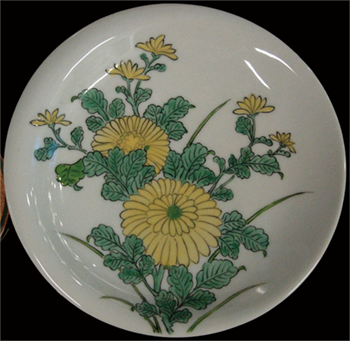All issues

Predecessor
Volume 84, Issue 12
Displaying 1-6 of 6 articles from this issue
- |<
- <
- 1
- >
- >|
The Special Issue / Chemistry and Colour Materials
Original Research Paper
-
Shigeyuki YAGI, Toshihiko OUE, Takeshi MAEDA, Hiroyuki NAKAZUMI, Yoshi ...2011 Volume 84 Issue 12 Pages 408-414
Published: December 20, 2011
Released on J-STAGE: March 16, 2012
JOURNAL FREE ACCESSIn order to develop a host polymer material applicable to solution-processed organic light-emitting diodes, a novel polymer consisting of the (1,1'-binaphthalene-6,6'-diyl)bis(9H-carbazole) monomer units was prepared, and a polymer light-emitting diode (PLED) containing a phosphorescent material was fabricated using the obtained polymer. The palladium-promoted Buchwald-Hartwig-type cross-coupling reaction of 2,2'-alkoxy-6,6'-dibromo-1,1'-binaphthalene with 9H-carbazole successfully led to the introduction of two carbazole groups to the binaphthalene skeleton. One of the obtained bis(carbazole) derivatives was converted to an acrylate-functionalized compound (mono-BNCz) in 3 synthetic steps, which was polymerized using a radical initiator to afford a novel polymer (poly-BNCz, Mw = 9680, Mn = 6580, and PDI = 1.47). The obtained polymer exhibited good solubility in common organic solvents such as chloroform and toluene, and provided excellent thin film formation by a solution process. Using poly-BNCz as a host polymer, a PLED containing a green-phosphorescent iridium(III) complex as an emitting dopant was fabricated. Upon application of an increasing voltage, green electroluminescence based on the emitting dopant was obtained from the PLED, and therefore, it was found that poly-BNCz is applicable to solution-processed OLEDs as a host material. Fig. 2 Fullsize ImageView full abstractDownload PDF (825K)
Fig. 2 Fullsize ImageView full abstractDownload PDF (825K)
Integrated Paper
-
Takashi KAWAHARA, Norio TSUBOKAWA2011 Volume 84 Issue 12 Pages 415-420
Published: December 20, 2011
Released on J-STAGE: March 16, 2012
JOURNAL FREE ACCESSPreparation of functional silica nanoparticle having antibacterial, biorepellent, and flame-retardant activity by grafting of polymers onto silica nanoparticles was reviewed. Antibacterial silica was successfully prepared by grafting of polymers having pendant phosphonium salt groups, poly(vinylbenzyltributylphosphonium chloride), onto the surface. The silicone rubber and paints filled with the antibacterial silica show strong antibacterial activity against Staphylococcus aureus and Escherichia coli. These composites retained the antibacterial activity even after the boiling in water for 24 h. On the contrary, silicone rubber filled with unimmobilized antibacterial polymer lost the antibacterial activity by boiling within 6 h. The immobilization of capsaicin was achieved by the reaction of hydroxyl groups of capsaicin with terminal isocyanate groups of poly(amidoamine)-grafted silica, which were introduced by the reaction of terminal amino groups of poly(amidoamine) grafted chain with hexamethylene diisocyanate. As the result of magnus test, it was found that the capsaicin-immobilized silica shows stimulus activity. The immobilization of halogen-type and phosphorous-type flame retardant onto silica surface was investigated. In addition, intercalation of capsaicin into interlayer of layered double hydroxide (LDH) was successfully achieved by coprecipitation method. Silicone resin filled with the capsaicin-intercalated LDH shows antifouling activity to barnacle cypris larvae.View full abstractDownload PDF (2252K)
Review
-
Masashi SHIBATA2011 Volume 84 Issue 12 Pages 421-425
Published: December 20, 2011
Released on J-STAGE: March 16, 2012
JOURNAL FREE ACCESSIn order to improve thermal stability and suppress elution of organic dyes, composites of the dyes and inorganic hosts have been investigated. In this paper, application of organic-inorganic composites as cosmetic color materials and recent studies on compositesin which the inorganic host is mesoporous silica are reported.View full abstractDownload PDF (1265K)
Digest
-
Yasuharu NAKAYAMA2011 Volume 84 Issue 12 Pages 426-434
Published: December 20, 2011
Released on J-STAGE: March 16, 2012
JOURNAL FREE ACCESSBinder of waterborne coatings contains plural resins and various additives. The crosslinking between different polymer phases is essential for the stability of hybrid structures. Furthermore, since the film properties are lowered by incorporation of low molecular weight additives to polymer hybrid film, fixing of the additives is necessary to realize high-performance. Similar crosslinking reactions are employed for these two purposes. In this work, we summarized broad information related to application technique of such crosslinking reactions.View full abstractDownload PDF (2544K)
Current Topics
-
Yoshimune NONOMURA, Naoto KOBAYASHI, Naoki NAKAGAWA2011 Volume 84 Issue 12 Pages 435-438
Published: December 20, 2011
Released on J-STAGE: March 16, 2012
JOURNAL FREE ACCESSSolid particles are adsorbed at liquid-liquid or air-liquid interfaces, and form stable emulsions and foams. Some complicated structures, i.e. network and bicontinuous structures, have been found recently. In this review, we explain some preparation methods of abnormal emulsions such as sweet potato-like emulsions, plum-like emulsions and non-spherical multiple emulsions. These findings are useful to develop functional materials for pharmaceutical, food, cosmetic and paint products.View full abstractDownload PDF (1240K) -
Toshiyuki MASUI, WENDUSU, Nobuhito IMANAKA2011 Volume 84 Issue 12 Pages 439-443
Published: December 20, 2011
Released on J-STAGE: March 16, 2012
JOURNAL FREE ACCESSInorganic pigments are applied to ceramics, glasses, plastics, paints and coatings as their color materials. However, a number of the conventional inorganic pigments contain toxic metal such as lead, hexavalent chromium, and cadmium. Since many people worry that they may adversely affect the human body and the environment, the regulations concerning the hazardous materials have been enhanced; e.g. Restriction of Hazardous Substances in Europe (RoHS). Therefore, potential substitutes for these pigments are highly demanded today. There are oxides, nitrides, and sulfides in inorganic pigments, but only oxide pigments are available at high temperatures where organic compounds are completely combusted. In this article, recent advance in environmental-friendly oxide pigments without any toxic and hazardous elements is reviewed for three primary colors; yellow, red, and blue. Fig. 4 Fullsize ImageView full abstractDownload PDF (2255K)
Fig. 4 Fullsize ImageView full abstractDownload PDF (2255K)
- |<
- <
- 1
- >
- >|